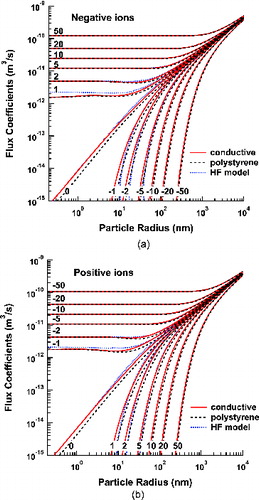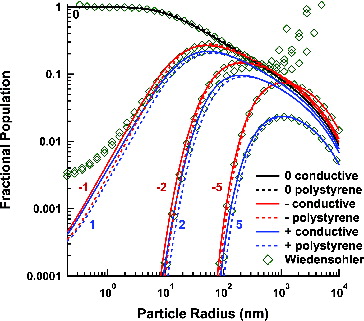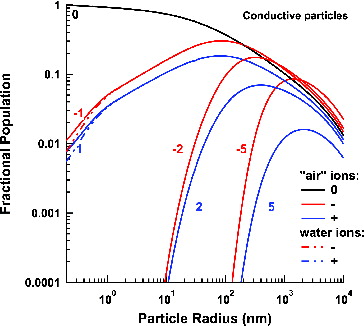Abstract
Copyright 2015 American Association for Aerosol Research
Article title: “Ion–Aerosol Flux Coefficients and the Steady-State Charge Distribution of Aerosols in a Bipolar Ion Environment”
Authors: Xerxes López-Yglesias and Richard C. Flagan
Journal: Aerosol Science and Technology
Bibliometrics: Volume 47, Issue 6, pages 688–704
DOI: 10.1080/02786826.2013.783684
Recently errors were found in the article “Ion–Aerosol Flux Coefficients and the Steady-State Charge Distribution of Aerosols in a Bipolar Ion Environment”. In the main text, an error in Equation (2) was discovered by Dr. Johannes Leppä at the California Institute of Technology. The correct form of the equation is . This correction has a significant effect on the flux coefficients of ions to particles at small particle sizes. For this reason Figures , , , and have been recalculated and are presented here. Figure has also had its trace colors altered from the original paper to better accommodate the color blind portion of the population.
In the appendix, the formula given to approximate the charge distribution has a typo and should read, . It was also unclear that the unit of
is meters.
Finally, the online supplemental information gave fit coefficients whose rounding errors made them unusable. The new Supplemental Information will no longer contain any tables. It will simply contain an index describing the content of each revised, delimited text file. Each row in a delimited text file contains the particle charge described by the fit, the fit coefficients, the minimum relative error, the maximum relative error, and the range of radii (in meters) over which the fit is valid. The fits for the steady state charge distributions have 12 () fit coefficients, describing particles with -25 to 25 charges on them at ground level and particles with -20 to 20 charges on them at 20 km. Those fits that describe the flux coefficients have 24 (
) fit coefficients and describe particles with -100 to 100 charges on them. The flux coefficients are described by a larger number of terms to minimize nonphysical behavior, crossing of the flux coefficient lines, due to errors in the fitting that appear at large particle sizes,
> 1
m. These new fit parameters will describe the data in the revised figures that follow.
FIG. 8. Flux coefficients for negative (a), and positive (b), ions to aerosol particles of various charge states.




